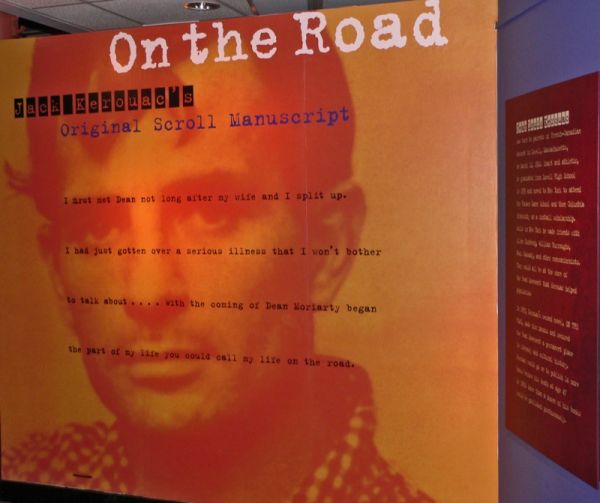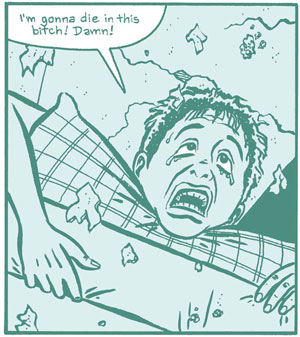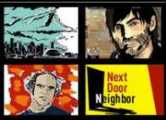The Story of Burning Man
Tuesday, August 21st, 2007MORE ON BURNING MAN
- READ an interview with Jessica Bruder about Burning Man.
- SEE a photo essay excerpted from Burning Book.
- BUY Burning Book.
- GO to the Burning Man web site for more images and info.
Prologue: Tinder
The Man is a wooden monument to nothing specific, in the middle of nowhere. He’s a stick figure drawn huge, a splinter jutting out of the Nevada desert.
He looks like a man only in the way folded paper looks like an airplane—suggestive lines, not much definition. Still, you can’t mistake him. Anchored to a giant pedestal, he rises eighty feet from the ground. When the sun drops behind the Granite Range to the west, his spindly frame lights up with neon tubes. You can see him glow like a truck stop sign from more than a mile away.
For the past week a temporary city has been swelling around him, hoisted out of the dust and duct-taped together by nearly forty thousand pairs of hands. The city is roughly circular, with the man as its axle. Everything turns, grows, and changes around him.
Win this book!
 Send SMITH your Burning Man story in 100 to 1000 words. Five storytellers will win a copy of Jessica Bruder’s brilliant and beautiful Burning Book.
Send SMITH your Burning Man story in 100 to 1000 words. Five storytellers will win a copy of Jessica Bruder’s brilliant and beautiful Burning Book.
Then, on Saturday evening, it’s the Man who changes. His arms rise slowly from his sides like levers on a corkscrew. The gesture is triumphant, but it also means that he doesn’t have much time left. Thousands of temporary homes—tents, RVs, geodesic domes draped in parachute fabric—are emptying. From all directions, revelers converge on the Man.
They’re dressed like Egyptian gods and leather angels, sci-fi space jockeys and feral children. They come on stilts and bicycles, dangling from cranes and cherry pickers, riding on the decks of homemade pirate ships. Their faces are streaked with glitter and dirt.
“Burn!”
“Burn it!”
“Burn him!”
All week long, these audience members were the show. But tonight they’re all part of the same crowd, watching.
With a sudden crack, fireworks spit into the sky from the base of the Man and explode. There’s a second volley, and the Man catches fire. Flames climb his skeletal torso.
Then, all at once, the Man falls. He tips like a bottle, hitting the ground in a draft of sparks.
Starting tomorrow, the week’s spell will break. Pieces of the city will be packed away in crates, consumed by fire, or dragged out in trash bags. There will be an exhausted exodus, and then a bleary reunion with jobs and bills, the cling of responsibility, and strangers who don’t meet your eyes in the street. The evening news will come from another desert, where a war is happening.
+++
BACK IN 1986, WHEN A FEW FRIENDS ROASTED A ROUGH-HEWN effigy on a San Francisco beach, they didn’t realize that they were founding a ritual. Their bonfire evolved from a small gathering into an annual party; gradually the event gathered steam, got a name, and exploded into the center of an enormous, celebratory metropolis. It spawned a scene so beguiling that people now travel from all over the world to take part in what has become America’s most fascinating festival.
Nowadays you can see the show from almost anywhere. Footage of the fire is transmitted to television sets across the country. There’s a free simulcast on the Internet.
You can also read the headlines. Dozens of them have distilled Burning Man since 1996, when Bruce Sterling’s big story made the cover of Wired magazine, crowning the festival “The New American Holiday.”
Since then, Burning Man has been called everything from “Woodstock at the Stake” to “The Neon Babylon,” “Pagan Sacrifice in the Nevada Desert,” “Operation Desert Swarm,” and “Bonfire of the Inanities.”
So why do the pilgrims, in growing numbers, still journey to that bleak desert? They go because the burning Man—a one-ton monument in flames—isn’t the whole of Burning Man.
They fill the desert with a staggering variety of art and amusements, gatherings and performances, and when the week is over, they scour the dust to make it all disappear. The festival runs on a simple credo: “no spectators.” To put it plainly, the city is the work of the people who live there. If everyone came to sit back and absorb the culture, there would be nothing for them to see.
For years observers have been identifying nebulous social forces to which Burning Man can be—must be!—a response: the rise of secular and corporate culture; the expansive connectivity (and later, the physical alienation) of the Internet; the hardening of America in an era of homeland security. These subtexts are interesting enough, but none of them quite scream, “Let’s go to the desert and make something!” They aren’t intimate enough to account for some subtler explosions: what actually happens in the desert when thousands of people embark on a collective experience.
That story is a journey: how they get there, what they do, and how they integrate a week’s worth of dust, ashes, and ideas into their lives after the last fire goes out. It’s about what they burn and, even more, about what they build.
MORE ON BURNING MAN
- READ an interview with Jessica Bruder about Burning Man.
- SEE a photo essay excerpted from Burning Book.
- BUY Burning Book.
- GO to the Burning Man web site for more images and info.
© 2007 by Jessica Bruder. Published by Simon Spotlight Entertainment, an imprint of Simon & Schuster, Inc. Printed with permission of Simon & Schuster, Inc.




 Expect sensory bombardment. Just when you’ve decided the scene is strange—maybe you’re walking around the festival and a gaggle of motorized cupcakes whizzes past, while a troupe of French maids is trying, ineffectually, to tidy up the desert with feather dusters, all in the shadow of a barn-sized rubber duck with a jazz club in its belly. Then things will probably get weirder.
Expect sensory bombardment. Just when you’ve decided the scene is strange—maybe you’re walking around the festival and a gaggle of motorized cupcakes whizzes past, while a troupe of French maids is trying, ineffectually, to tidy up the desert with feather dusters, all in the shadow of a barn-sized rubber duck with a jazz club in its belly. Then things will probably get weirder.
























 The second anniversary of Hurricane Katrina is a big story—10 major Time, Inc. publications, for example, are featuring Katrina coverage according to
The second anniversary of Hurricane Katrina is a big story—10 major Time, Inc. publications, for example, are featuring Katrina coverage according to 

 Here’s an interesting meta-personal media moment:
Here’s an interesting meta-personal media moment: 



